Cast Iron Salmon
This cast iron salmon is a delicious and healthy dish that is perfect for any occasion. This quick weeknight recipe takes just 10 minutes! Everything is made in one skillet. The salmon has a beautiful crispy crust and tender inside. This quick and easy recipe is great for many occasions. Serve it for family dinners, holidays, and more!
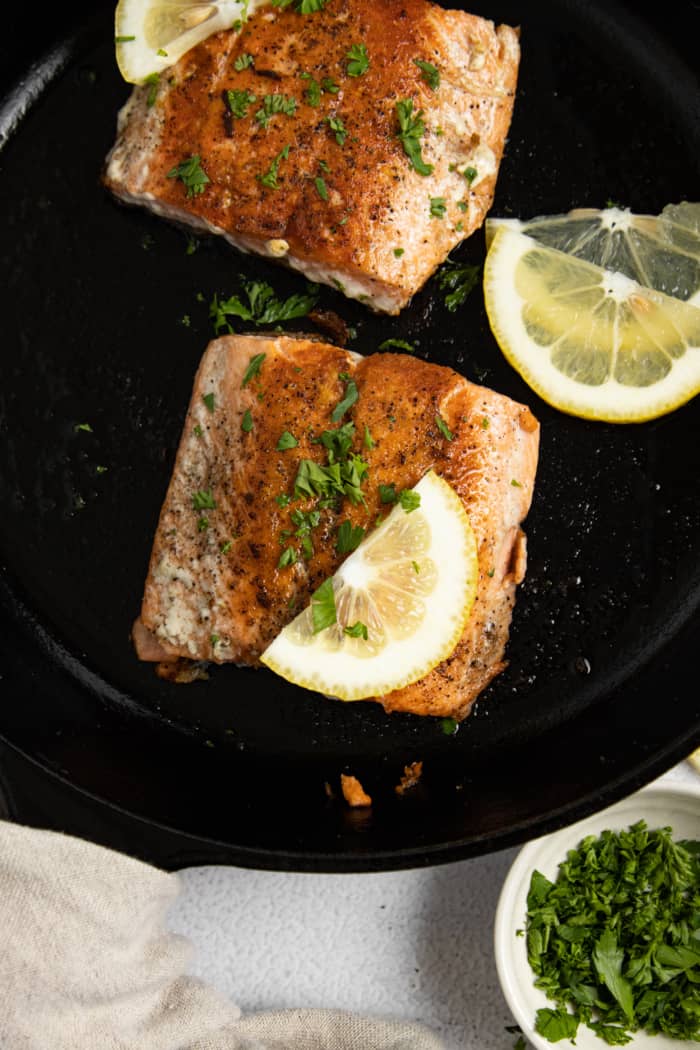
Why You’ll Love This Recipe
There are many reasons why you will love this recipe for cast iron salmon.
- This salmon recipe requires just 4 main ingredients.
- It is tender and crispy. So is this Halibut recipe!
- The salmon is cooked to perfection and has a crispy skin and flaky flesh.
- It is quick and easy to make. Only 10 minutes from start to finish.
- This recipe is healthy and nutritious.
- Salmon is a good source of protein and omega-3 fatty acids, which are beneficial for heart health.
- This salmon is great for family dinners. Serve with potatoes, roasted vegetables, or a side salad.
- This recipe is inspired by my recent trip to Alaska! They had the freshest salmon.
- Quick enough for busy weeknights!
- This salmon tastes restaurant quality.
- This recipe is Whole30 compliant, Paleo, Keto, low carb, gluten free, dairy free, egg free, nut free, and sugar free.
- Great for many diets and lifestyles.
- Check out this Sockeye Salmon for another easy dinner recipe!
Ingredients & Substitutes
These are the main ingredients and substitutions for this homemade cast iron skillet recipe. Scroll down to the recipe card for the full ingredients list and instructions.
Choose salmon fillets with or without skin. About 6 ounces is a good size for this recipe.
Both olive oil and melted butter work well. For dairy free, use olive oil or avocado oil.
Season the fillets with sea salt and pepper.
Serve with lemon wedges and fresh herbs if desired.
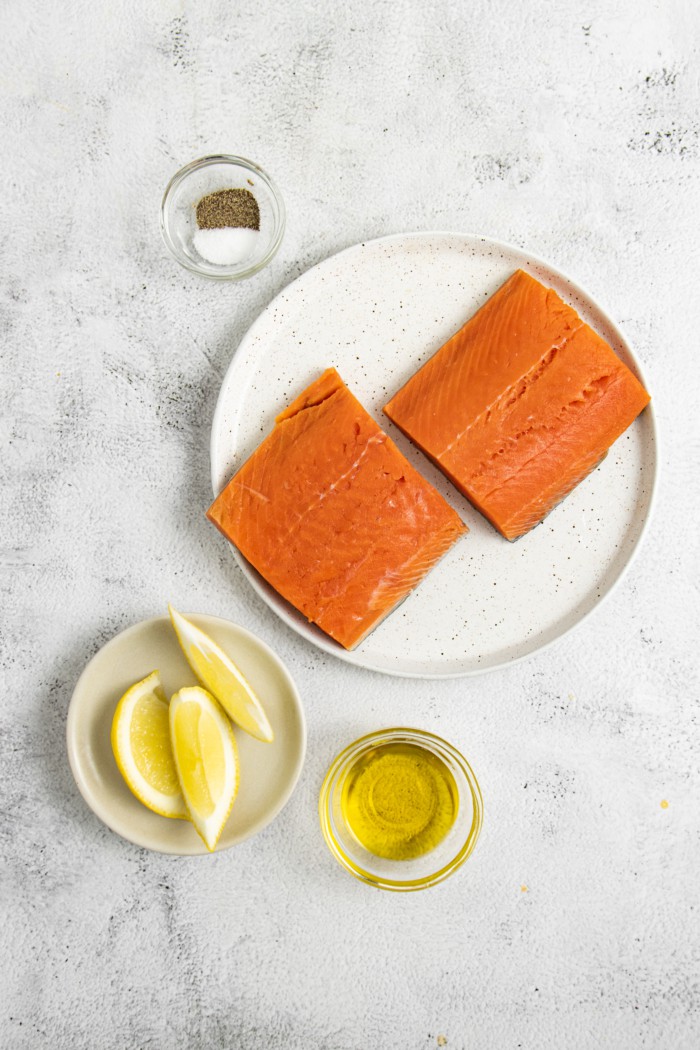
Taste & Texture
This cast iron salmon has crispy skin and flaky flesh.
The salmon develops a delicious smoky flavor from the cast iron skillet.
Overall, the taste is hearty, fresh, and delicious!
How to Make
Step 1
First, preheat your oven to 400°F (200°C).
Step 2
Pat the salmon fillets dry with paper towels to remove any excess moisture. This will help the salmon sear better.
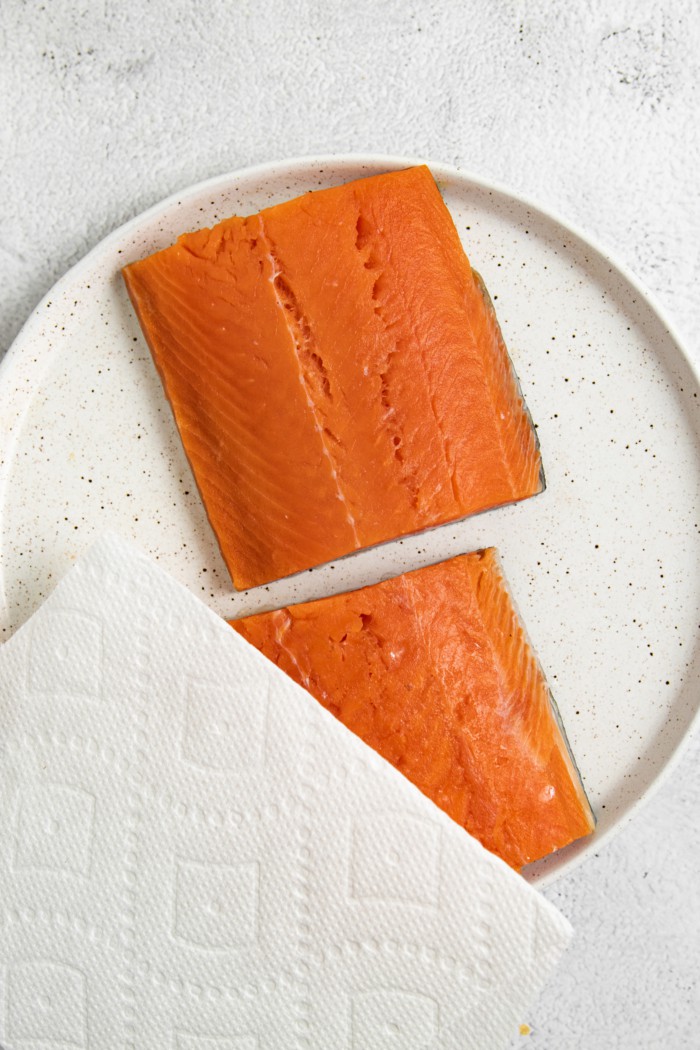
Step 3
Season both sides of the salmon fillets with sea salt and black pepper.
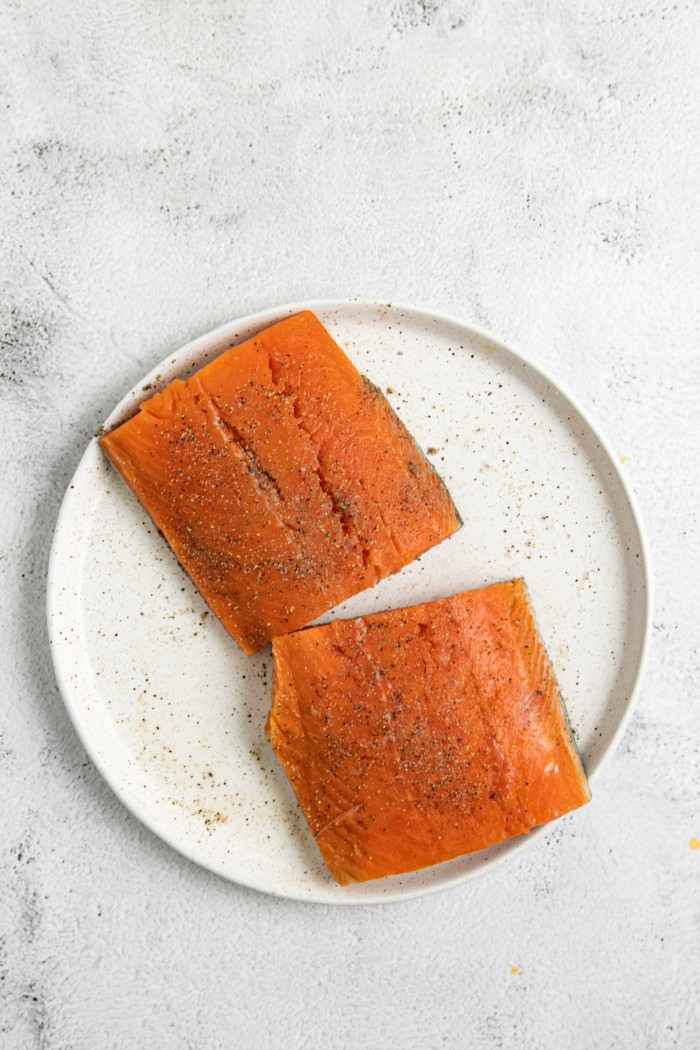
Step 4
Place a cast-iron skillet on the stovetop over medium-high heat. Add the olive oil or melted butter to the skillet and swirl it around to coat the bottom evenly.
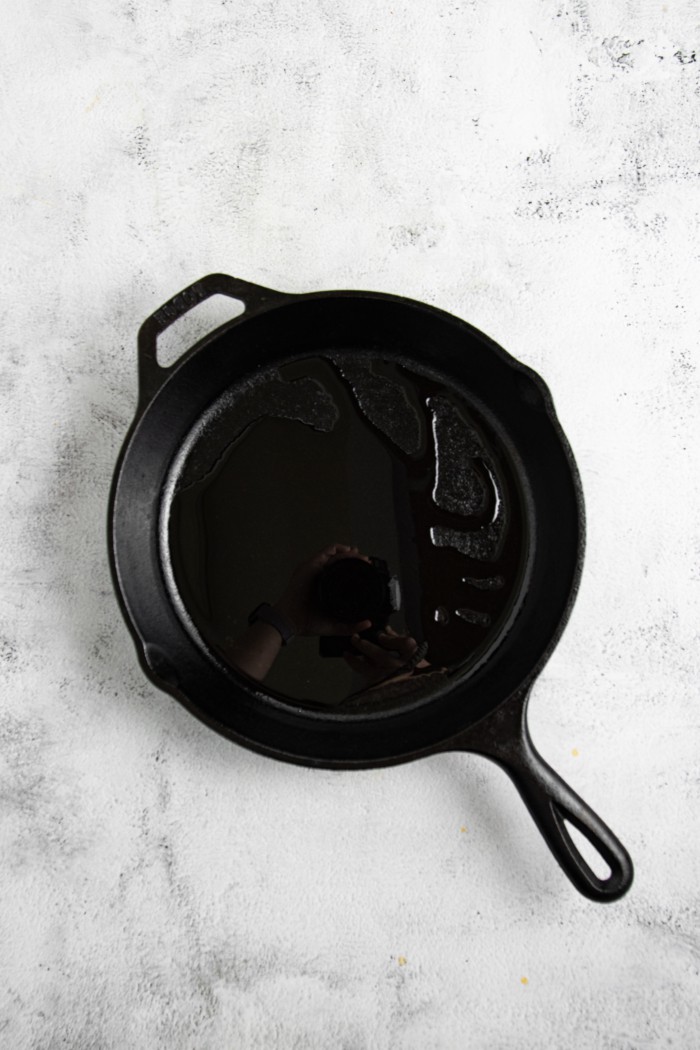
Step 5
Once the skillet is hot, carefully place the salmon fillets in the pan, skin-side down if using skin-on fillets.
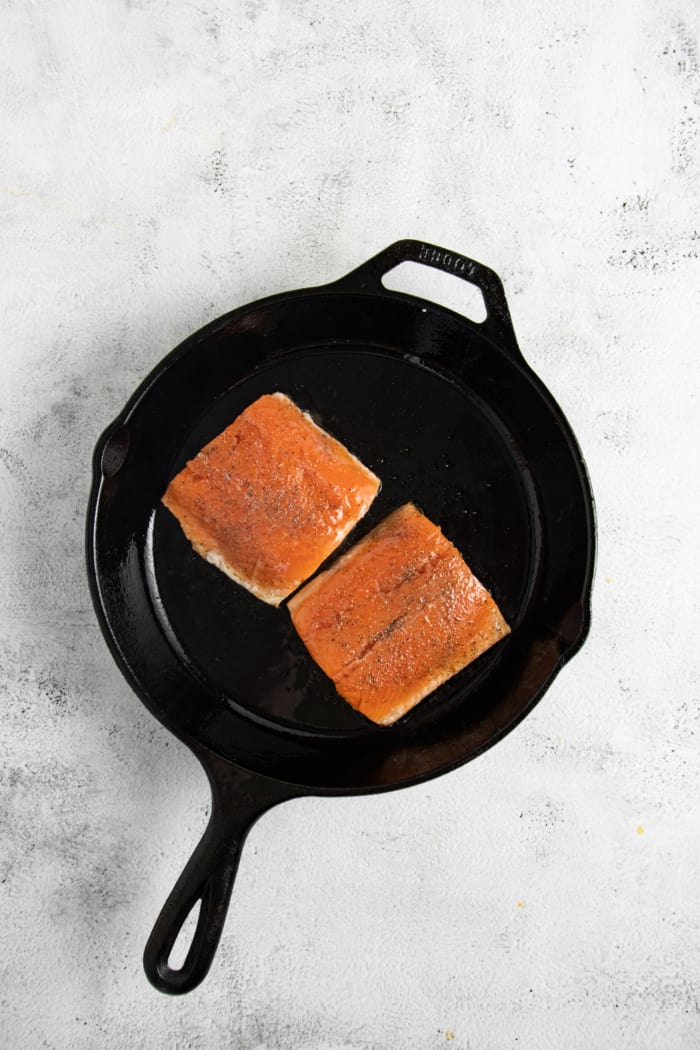
Step 6
Cook the salmon on the stovetop for about 2 to 3 minutes to get a nice sear on the bottom.
Step 7
Flip the salmon fillets using a spatula and transfer the skillet to the preheated oven.
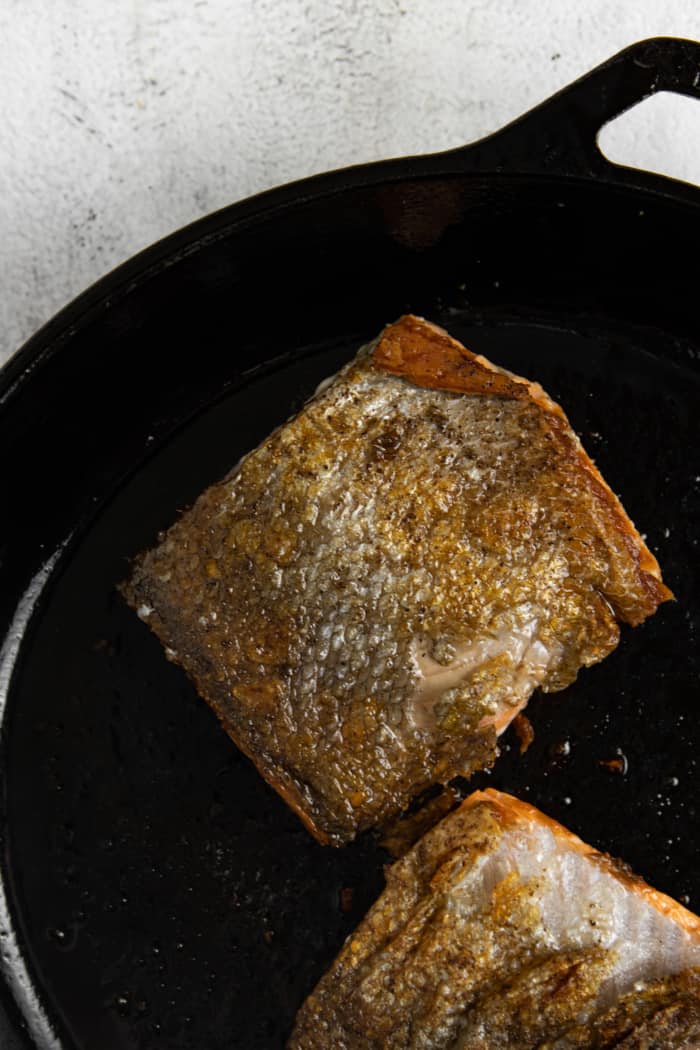
Step 8
Let the salmon finish cooking in the oven for about 6 to 8 minutes, depending on the thickness of the fillets. The internal temperature of the salmon should reach 135°F for doneness.
Step 9
Then, remove the skillet from the oven. Let the salmon rest for a minute or two before serving.
Step 10
Finally, serve with lemon wedges and fresh herbs on top!
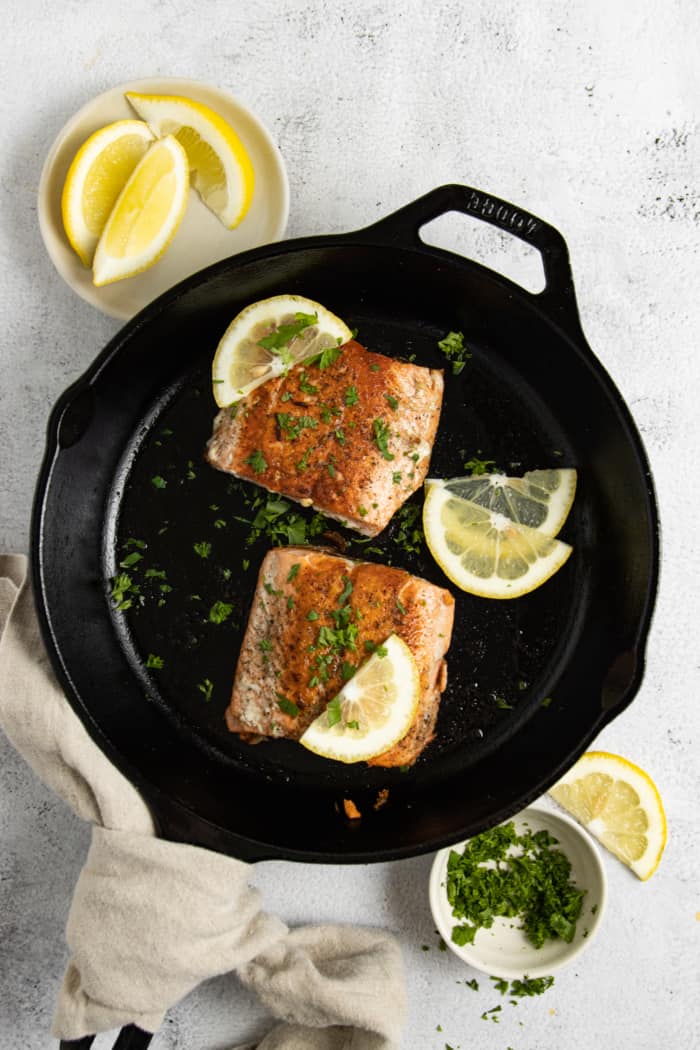
Different Types of Cooking Methods
There are many different ways to cook cast iron salmon. Some popular methods include:
- Pan-frying: This is the classic method for cooking cast iron salmon. Simply heat the cast iron skillet over medium-high heat and add a small amount of oil. Season the salmon with salt and pepper and cook for 3 to 4 minutes per side, or until cooked through.
- Grilling: This is a great way to cook salmon if you are looking for a healthier option. Preheat the grill to medium heat and brush the salmon with olive oil. Season with salt and pepper and cook for 4 to 5 minutes per side, or until cooked through.
- Baking: This is a great way to cook salmon. Preheat the oven to 400 degrees Fahrenheit and place the salmon in a greased baking dish. Season with salt and pepper and bake for 15 to 20 minutes, or until cooked through.
Expert Tips for Success
Here are a few expert tips and tricks for cooking the best cast iron salmon.
Use high-quality salmon. If possible, use wild-caught salmon.
Use a good quality cast iron skillet. A good quality cast iron skillet will help to ensure that the salmon cooks evenly and develops a crispy skin.
Use a meat thermometer.
The salmon should be cooked to an internal temperature of 135 degrees Fahrenheit.
Flavor Variations & Add-Ins
Here are some delicious ways to switch up the flavors of this cast iron salmon.
Lemon garlic butter sauce: In a small bowl, combine melted butter, lemon juice, garlic powder, and salt and pepper. Drizzle the sauce over the salmon before serving.
Herbed salmon: Add fresh herbs, such as parsley, dill, and thyme, to the salmon before cooking.
Maple Dijon salmon: Combine maple syrup and Dijon mustard in a small bowl. Brush the salmon with the mixture before cooking. Check out this Candied Salmon for the full recipe.
How to Serve & Store
Cast iron salmon is best served hot and fresh from the oven!
Serve with mashed potatoes, roasted veggies, or a side salad.
Feel free to add some Korean BBQ sauce or a honey garlic sauce on top.
Store leftovers in the refrigerator for up to 3 days.
To reheat, simply reheat it in a pan on the stovetop or in the oven.
Frequently Asked Questions (FAQs)
You can use any type of salmon for cast iron salmon, but wild-caught salmon is the best option. Wild-caught salmon is higher in omega-3 fatty acids than farmed salmon.
You can season cast iron salmon with any seasonings that you like. Some popular choices include salt, pepper, lemon juice, and herbs.
You can add a layer of butter or olive oil to the bottom of the cast iron skillet before cooking the salmon. You can also add herbs or spices to the butter or olive oil.
Yes, you can cook salmon on a cast iron skillet by searing it skin side down over medium-high heat until crispy, then flipping and cooking until the flesh is opaque.
Cast iron is generally better for salmon than nonstick because it provides a more even sear and crispier skin.
Cook the salmon over medium high heat in a skillet.
Use a meat thermometer to determine when the salmon is done cooking.
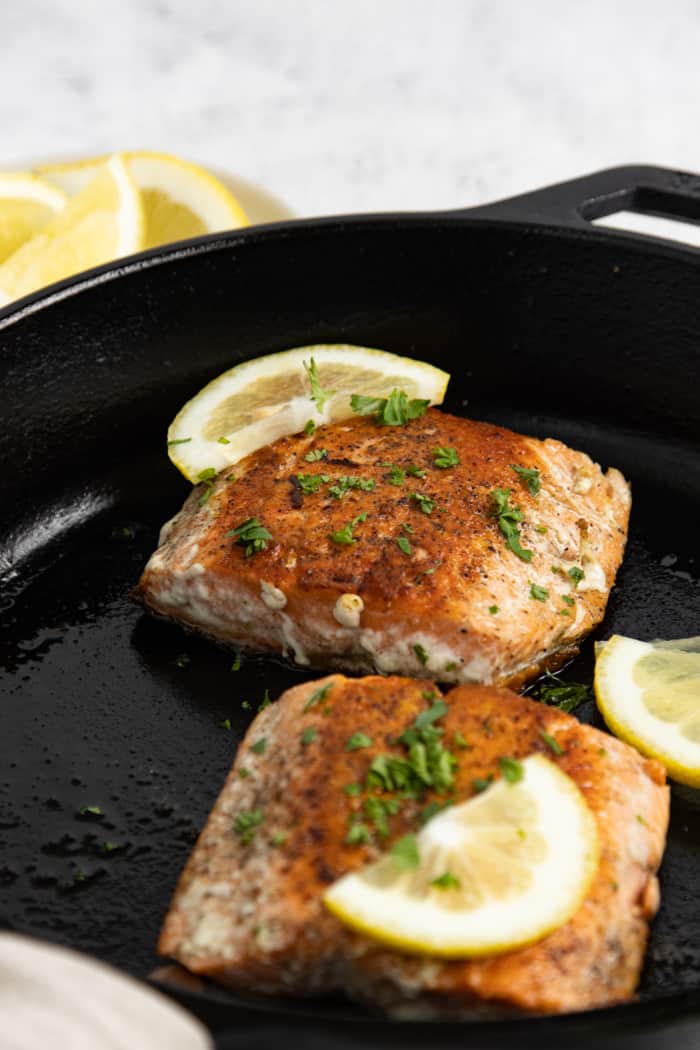
Equipment Needed
Cast Iron Skillet: This 12-inch cast iron skillet is perfect for cooking salmon fillets.
Check out all of my kitchen favorites!
YOU MAY ALSO LIKE
If you make this salmon in a cast iron skillet recipe, I would really appreciate a review! You can find me on Instagram, Facebook, and Pinterest. Join my exclusive Facebook Group for a behind the scenes look. I would love for you to follow along! For more ideas, see these Lunch and Dinner Recipes.


Get the Recipe: Cast Iron Salmon
Ingredients
- 2 salmon fillets, about 6 ounces each, skin-on or skinless
- 1 tbsp olive oil, or melted butter
- sea salt, to taste
- black pepper, to taste
- lemon wedges, for serving
- fresh herbs, for garnish
Instructions
- First, preheat your oven to 400°F (200°C).
- Pat the salmon fillets dry with paper towels to remove any excess moisture. This will help the salmon sear better.
- Season both sides of the salmon fillets with salt and pepper.
- Place a cast iron skillet on the stovetop over medium high heat. Add the olive oil or melted butter to the skillet and swirl it around to coat the bottom evenly.
- Once the skillet is hot (but not smoking), carefully place the salmon fillets in the pan, skin side down if using skin-on fillets. Be cautious of any oil splatters.
- Cook the salmon on the stovetop for about 2 to 3 minutes to get a nice sear on the bottom. You should see a golden crust forming.
- Flip the salmon fillets using a spatula and transfer the skillet to the preheated oven.
- Let the salmon finish cooking in the oven for about 6 to 8 minutes, depending on the thickness of the fillets. The internal temperature of the salmon should reach 135°F for doneness.
- Remove the skillet from the oven and let the salmon rest for a minute or two before serving.
- Finally, garnish with fresh herbs. Serve with lemon wedges.
Notes
- For the best flavor, choose wild caught salmon. It is healthier and more flavorful.
- Use a good quality cast iron skillet. This helps evenly cook the salmon.
- To measure internal temperature, use a meat thermometer. Salmon should be cooked to 135 degrees Fahrenheit internally.
- Store leftovers in the fridge for up to 3 days.
Love this crispy cast iron salmon? You can sign up here to receive healthy meal plans, exclusive new recipes, and updates!
